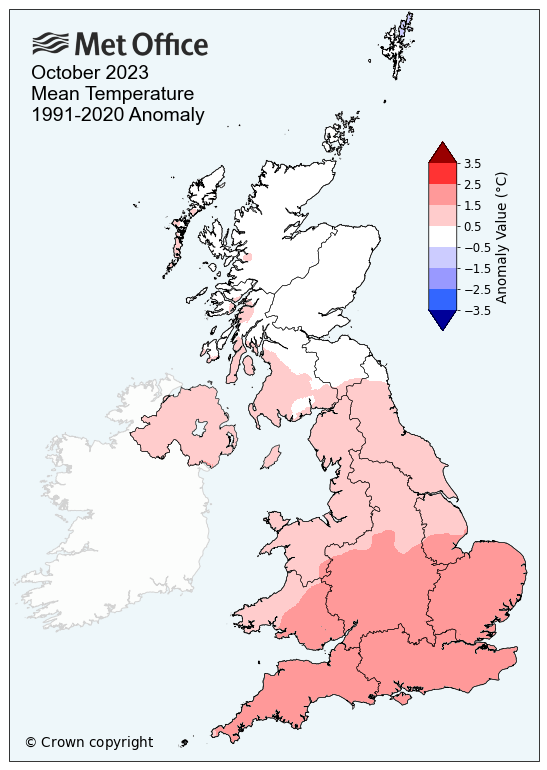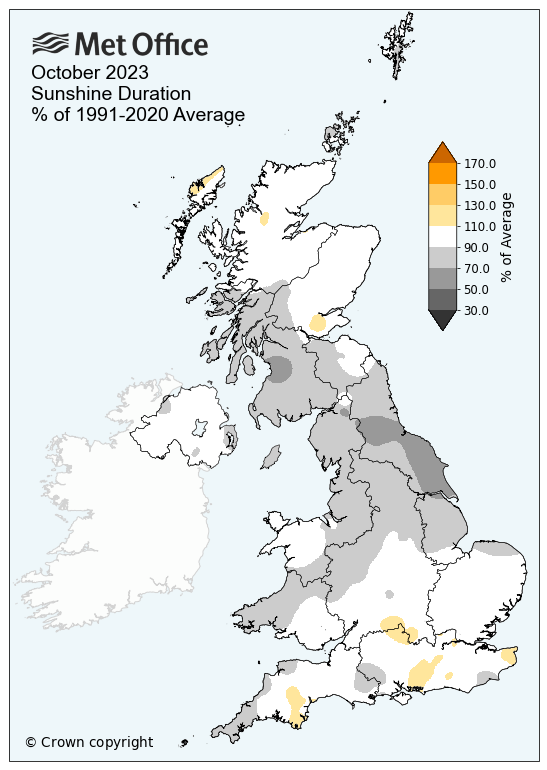Eastern Scotland had its wettest October on record in a series which goes back to 1836, with some counties seeing well over twice their average rainfall for the month, according to provisional Met Office figures.
Eastern Scotland broke its record for rainfall in October, with 235.9mm of rain being 82% more than its average. There were significant and very severe flood impacts in the area during Storm Babet, with two red rain warnings issued by the Met Office.
In more granular detail, Angus, Dundee, Fife and Kincardineshire were among a number of counties that recorded their wettest October on record as Storm Babet followed early month exceptional rainfall in a sodden period for many.
A month of rain
The UK had over a third more rain than average with 171.5mm (40% more than average) in what was provisionally the joint-sixth wettest October on record.
Northern Ireland had its fifth wettest October on record with 191.8mm being 68% more than its average. England had its eighth wettest on record with 147.2mm of rain, which is 63% more than average.
In addition to some counties in the east of Scotland; Staffordshire, Nottinghamshire and the Isle of Wight also provisionally had their respective wettest October on record. In Northern Ireland, counties Armagh and Down also had their wettest October.

The start of the month saw a marked north-south contrast in weather across the UK. Scotland bore the brunt of rainfall from Atlantic fronts, with 6 to 7 October the wettest 2-day period on record for Scotland in a series from 1891. Further south, England and Wales saw a significant warm, dry and sunny spell with temperatures widely in the low 20s °C and 25°C on four consecutive days in the south-east.
Since then however, rainfall has never been too far away from the UK, with figures increasing dramatically from Storm Babet’s influence on 18 to 21 October.
Babet’s impacts on England and Wales were chiefly felt from 18 to 20 October, in what was the third-wettest 3-day period for England and Wales in a series from 1891, while the Midlands provisionally recorded its wettest 3-day period on record. Eastern Scotland also saw exceptional rainfall as part of the event, with 200mm of rain falling in some of the wettest areas.
Met Office Senior Scientist Michael Kendon said: “Despite some warmth in the south early on, October 2023 overall goes down as a wet month for much of the UK, with some areas seeing record-breaking levels of rainfall.
“From mid-month, a blocking high set up over Scandinavia has tended to prevent low pressure systems from clearing the UK to the east. Associated with this, the frequent unusual south-easterly flow in eastern Scotland has particularly contributed to the wet month in this area – normally one of the driest parts of the UK.
“Interestingly, areas to the west, where you’d typically see more rain at this time of year, have been sheltered by the mountains from the worst of the weather, with generally below average rainfall during the month. This has helped prevent national figures from threatening any records.”
Rainfall and climate change
As the atmosphere warms due to human induced climate change it can hold more moisture, at a rate of around 7% more moisture for every degree of warming. On a simple level, this explains why in many regions of the world projections show an increase in precipitation as a consequence of human induced climate change.
The UK’s observations show large variability in annual, seasonal, and decadal rainfall. However, overall they also show that not only is our climate getting warmer, it is also getting wetter, consistent with this expected increase. In particular, several different measures show a slight increase in heavy rainfall in recent decades.
In the future, climate projections for the UK indicate that in October, November and December, areas of the UK will likely see more days with rainfall totals over 50mm, but particularly in the west.
Mild month for some

Despite the wet weather, temperatures have generally remained above average for the month, with southern England the warmest compared to average – typically between 1.5 and 2°C above the 1991-2020 October long term average.
For most counties in the south of England, the October mean temperature was within their respective top ten for the month, though none reached any record levels.
The UK’s mean temperature of 10.8°C in October 2023 is 1°C above average, though areas further north were generally closer to average. Scotland’s mean temperature of 8.3°C was 0.2°C above average.
Sun in short supply

As expected with frequent and heavy rain, it was a rather dull month, particularly across central parts of the UK, with below average hours of sunshine for many.
The UK had an average of 84.8 hours of sunshine in the month, which is 8% less than the long-term average. Northern England had a particularly dreary month, with 73 hours of sunshine being 22% fewer than its average for the month.
|
Provisional statistics October 2023 |
Max temp (°C) |
Min temp (°C) |
Mean temp (°C) |
Rainfall (mm/%) |
Sunshine (hours/ %) |
|||||
|
Actual |
91/20 Anom |
Actual |
91/20 Anom |
Actual |
91/20 Anom |
Actual |
91/20 Anom |
Actual |
91/20 Anom | |
|
UK |
14.0 |
0.9 |
7.6 |
1.1 |
10.8 |
1.0 |
171.5 |
140 |
84.8 |
92 |
|
England |
15.6 |
1.5 |
8.6 |
1.5 |
12.1 |
1.5 |
147.2 |
163 |
94.8 |
92 |
|
Wales |
14.5 |
1.2 |
8.5 |
1.6 |
11.5 |
1.4 |
208.6 |
132 |
82.8 |
90 |
|
Scotland |
11.1 |
-0.2 |
5.6 |
0.4 |
8.3 |
0.2 |
198.7 |
118 |
69.4 |
93 |
|
Northern Ireland |
13.9 |
1.0 |
7.9 |
1.5 |
10.9 |
1.3 |
191.8 |
168 |
80.1 |
94 |
Provisional temperature, rainfall and sunshine statistics for October 2023
Season so far
With two months of meteorological Autumn down, the season so far has been warmer than average, particularly in the south, while many parts in the east of Scotland, England and Northern Ireland have already had more than their average rainfall for the whole season – and a few spots as much as 150% – with a month still to go.
At this point in the season, you’d expect places to have had around 67% of their average rainfall for the whole season.
With a month of the season still to go, there’s plenty of chance for the figures to adjust before the conclusion of meteorological autumn. Storm Ciaran and the generally unsettled outlook are likely to see the autumn rainfall figures continue to increase substantially.


